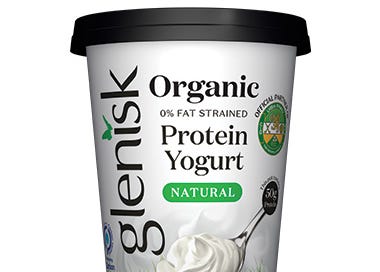Glenisk high protein yogurt
It was fortunate that I got to try this product so soon after the Sainsburys high protein yogurt as I may otherwise have skipped over some of the details that they had in common in their presentation.
Like Sainsburys, Glenisk eschewed the opportunity to label their product as Greek or Skyr style, opting for the health halo of ‘high protein’.
An additional similarity is the nationalist iconography that accompanies the yogurt. This is much more difficult to do if the product is labelled Greek or Icelandic style – it kind of undercuts the message of uniqueness and terroir.
However, Glenisk addresses this head on in the marketing message on the side on of the pot, which notes that their yogurt is redolent of the Greek and Icelandic styles but ‘Irish in its own way’.
There is green grass trim at the bottom of the pot, and a number of badges promoting Irish food produce and an Offaly GAA badge as Glenisk sponsors the county team.
I can see on google images that in the past the product was labelled ‘Irish strained protein yogurt’ in an attempt to further nationalize the product, but that seems to have been done away with now.
The milk used is organic which is standard across the Glenisk range. This represents both a value-added and an additional health halo to differentiate from competitors. The packaging is also fully recyclable and carbon neutral. All in all the pot is laden with information and messaging of various kinds, emphasizing the conscious consumer market that Glenisk is targeting.
The Glenisk story is quite interesting as the website notes the Cleary family have held the farm for three generations now. The yogurt business was established 35 years ago. At one point dairy giant Danone held a 38% share but that was sold back to the Cleary family in 2021. Although it is a small company in comparison to international giants like the Kerry group, Glenisk is (self-reportedly) the fasting growing brand in the yogurt sector.
Establishing a company worth millions just a few decades after starting from the kitchen table illustrates the huge growth in the healthy dairy industry that has taken off in the last few decades, as before this yogurt would have been a niche product in Ireland, probably aimed at children, if it was sold at all.
Personally the only yogurt product I remember from my childhood is petit filous, a French product that is technically cheese (fromage frais), which just underscores the lack of yogurt even within the yogurt market itself at that time.
Taste and experience
This yogurt has a nice texture, obviously quite thick yet slightly fluffy, with no visible whey.
The abstemious nature of high protein diet culture is fully on display through this yogurt’s flavour profile. This carried a slight funk associated with fermented foods (obviously yogurt is fermented, but normally it doesn’t share a flavour profile with beer or kombucha). This is no doubt at the forefront due to the almost total lack of sweetness. It is soft and yielding when eaten, which is preferable to some of the thicker products I have reviewed, but the tartness stays in the back of the throat for a long time.
Most British products I’ve tried have had anything between 4g and 6g of sugar content even when they are high protein, whereas this only contains 2.4g of sugar per 100g. It is undoubtedly the least sweet yogurt I’ve tried in a while, but the bacteria/fermentation process must be quite well managed as it is not as sour as might be expected.
Notably this product contains lactobacillus rhamnosus, not commonly found in British yogurts that I have seen, but it is in Yakult and other yogurt-based products targeted at the gut health market.
This may also explain the lower than average sugar/carb content as the bacteria feed on lactose, the natural sugar in milk. The additional bacteria may also explain a slightly sour flavour profile that is nonetheless easy to eat.




